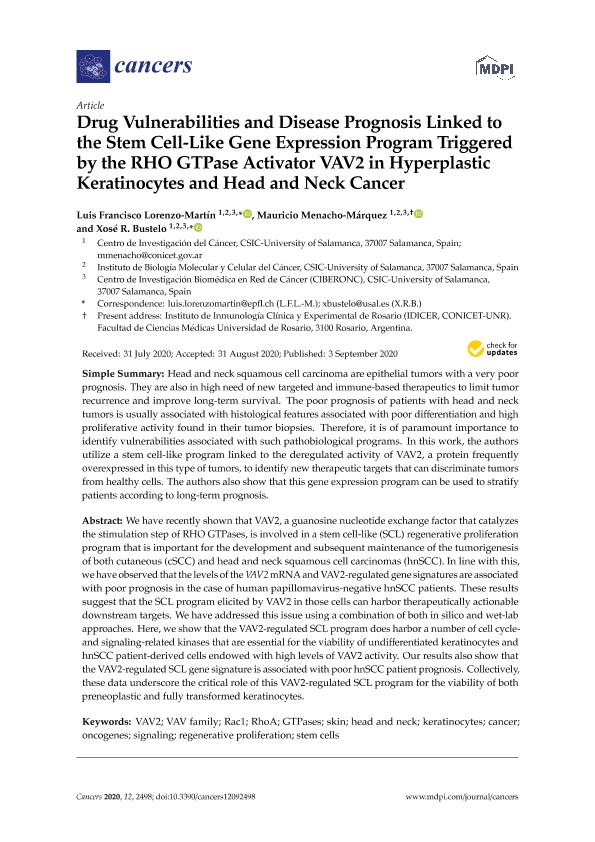Mostrar el registro sencillo del ítem
dc.contributor.author
Lorenzo Martín, Luis Francisco
dc.contributor.author
Menacho Márquez, Mauricio Ariel

dc.contributor.author
Bustelo, Xosé R.

dc.date.available
2021-11-02T11:22:07Z
dc.date.issued
2020-09
dc.identifier.citation
Lorenzo Martín, Luis Francisco; Menacho Márquez, Mauricio Ariel; Bustelo, Xosé R.; Drug vulnerabilities and disease prognosis linked to the stem cell-like gene expression program triggered by the RHO GTPase activator VAV2 in hyperplastic keratinocytes and head and neck cancer; Molecular Diversity Preservation International; Cancers; 12; 9; 9-2020; 1-15
dc.identifier.issn
2072-6694
dc.identifier.uri
http://hdl.handle.net/11336/145681
dc.description.abstract
We have recently shown that VAV2, a guanosine nucleotide exchange factor that catalyzes the stimulation step of RHO GTPases, is involved in a stem cell-like (SCL) regenerative proliferation program that is important for the development and subsequent maintenance of the tumorigenesis of both cutaneous (cSCC) and head and neck squamous cell carcinomas (hnSCC). In line with this, we have observed that the levels of the VAV2 mRNA and VAV2-regulated gene signatures are associated with poor prognosis in the case of human papillomavirus-negative hnSCC patients. These results suggest that the SCL program elicited by VAV2 in those cells can harbor therapeutically actionable downstream targets. We have addressed this issue using a combination of both in silico and wet-lab approaches. Here, we show that the VAV2-regulated SCL program does harbor a number of cell cycleand signaling-related kinases that are essential for the viability of undifferentiated keratinocytes and hnSCC patient-derived cells endowed with high levels of VAV2 activity. Our results also show that the VAV2-regulated SCL gene signature is associated with poor hnSCC patient prognosis. Collectively, these data underscore the critical role of this VAV2-regulated SCL program for the viability of both preneoplastic and fully transformed keratinocytes.
dc.format
application/pdf
dc.language.iso
eng
dc.publisher
Molecular Diversity Preservation International

dc.rights
info:eu-repo/semantics/openAccess
dc.rights.uri
https://creativecommons.org/licenses/by-nc-sa/2.5/ar/
dc.subject
CANCER
dc.subject
GTPASES
dc.subject
HEAD AND NECK
dc.subject
KERATINOCYTES
dc.subject
ONCOGENES
dc.subject
RAC1
dc.subject
REGENERATIVE PROLIFERATION
dc.subject
RHOA
dc.subject
SIGNALING
dc.subject
SKIN
dc.subject
STEM CELLS
dc.subject
VAV FAMILY
dc.subject
VAV2
dc.subject.classification
Bioquímica y Biología Molecular

dc.subject.classification
Ciencias Biológicas

dc.subject.classification
CIENCIAS NATURALES Y EXACTAS

dc.title
Drug vulnerabilities and disease prognosis linked to the stem cell-like gene expression program triggered by the RHO GTPase activator VAV2 in hyperplastic keratinocytes and head and neck cancer
dc.type
info:eu-repo/semantics/article
dc.type
info:ar-repo/semantics/artículo
dc.type
info:eu-repo/semantics/publishedVersion
dc.date.updated
2021-04-28T20:38:07Z
dc.journal.volume
12
dc.journal.number
9
dc.journal.pagination
1-15
dc.journal.pais
Suiza

dc.description.fil
Fil: Lorenzo Martín, Luis Francisco. Consejo Superior de Investigaciones Científicas; España. Universidad de Salamanca; España
dc.description.fil
Fil: Menacho Márquez, Mauricio Ariel. Consejo Nacional de Investigaciones Científicas y Técnicas. Centro Científico Tecnológico Conicet - Rosario. Instituto de Inmunología Clinica y Experimental de Rosario. Universidad Nacional de Rosario. Facultad de Ciencias Médicas. Instituto de Inmunología Clinica y Experimental de Rosario; Argentina
dc.description.fil
Fil: Bustelo, Xosé R.. Universidad de Salamanca; España. Consejo Superior de Investigaciones Científicas; España
dc.journal.title
Cancers
dc.relation.alternativeid
info:eu-repo/semantics/altIdentifier/url/https://www.mdpi.com/2072-6694/12/9/2498
dc.relation.alternativeid
info:eu-repo/semantics/altIdentifier/doi/http://dx.doi.org/10.3390/cancers12092498
Archivos asociados
